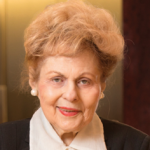New York Law Journal Lifetime Achievement: Scott E. Mollen
"Based on his extraordinary accomplishments as a lawyer, legal educator and public servant, Scott has indeed earned the Lifetime Achievement Award."
By Hon. Betty Weinberg Ellerin
I have known and admired Scott since he was a young lawyer who argued cases before me at the Appellate Division and more recently when we served as co-counsel in complex litigation matters.
While maintaining a substantial commercial litigation practice, Scott somehow found time to improve the education of law students, lawyers and judges. Scott may be the longest running real estate litigation columnist in America. His New York Law Journal column began in November 1987, and he has authored more than 1,700 columns.
He has regularly lectured at the Judicial Institute of the NYS Office of Court Administration, PLI, and many bar associations throughout the State.
Scott won cases in the N.Y. Court of Appeals involving fiduciary duties of lawyers, Separation of Church and State and the public procurement process. He helped lead the Anti-Defamation League’s lobbying effort, which achieved enactment of New York’s first Hate Crimes Law and for which he received the ADL’s Human Relations Award. As a member of the court’s “Craco Committee,” he supported creation of an ethics institute, mandatory legal education, standards of civility, statements of client rights and responsibilities, attorney discipline and improved court management.
Scott taught Alternate Dispute Resolution at St. John’s University School of Law and served as Chairperson of the NYC Rent Guidelines Board and as a Trustee of the Brooklyn Public Library.
The following are examples of a few of his noteworthy cases and professional contributions:
- Following the deadly attacks on 9/11, he successfully defended Motorola in an investigation of whether its two-way radios were defective and hindered emergency responders, it being found that the performance issues resulted from insufficient training. [Motorola was paid 100% of its bill.]
- Successful defense of the developer of an approximately $1 billion-dollar NYC development where the trial court ordered removal of more than 20 stories of an already “topped out” 52-story residential building, but the Appellate Division reversed.
- Prevailed before the N.Y. Court of Appeals in litigation involving “Separation of Church and State” issues. The case involved internal leadership disputes within one of the largest Hasidic groups in the world, the Satmar community.
- Successful defense of a former corporate officer’s $100 million claim for the value of his stock options. Based on the “Faithless Servant Doctrine”, the entire claim was dismissed.
- In a high profile federal public corruption case, he helped convince the government to dismiss all charges even though a grand jury already voted to indict. There were no “side deals” or cooperation involved.
- As a member of the NYS Supreme Court Commercial Division Advisory Council, he helped draft proposed rules involving virtual evidentiary hearings and non-jury trials and mandatory settlement conferences.
- As a member of the Mayor’s Judiciary Committee and the City Bar Association’s Judiciary Committees, Scott helped screen hundreds of candidates for judgeships and reviewed the candidacies of U.S. Supreme Court Justices Gorsuch, Kavanaugh and Jackson.
Scott also served as a volunteer federal mediator for Superstorm Sandy cases, as a legal marshal at the Kent State protest demonstration in Washington D.C, and as President of an organization which provided free orthodontic care for underprivileged children, sponsored a wheel chair basketball team and supported senior citizen programs.
Based on his extraordinary accomplishments as a lawyer, legal educator and public servant, Scott has indeed earned the Lifetime Achievement Award.

Betty Weinberg Ellerin was the Presiding Justice of the Appellate Division, First Department, and is now senior counsel at Alston & Bird.
This article originally appeared in the October 6, 2022 edition of the New York Law Journal. To view the full article on the NYLJ website, please click here.

